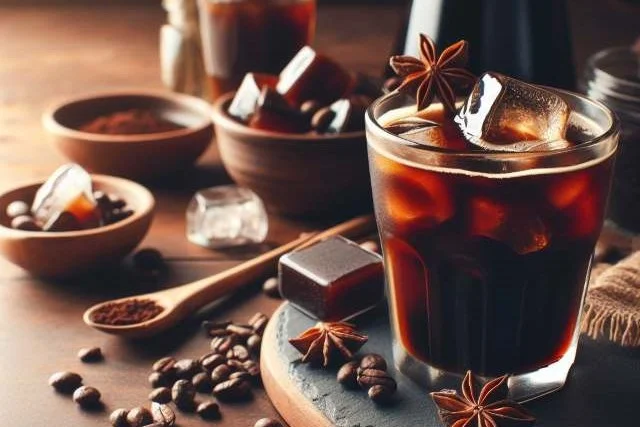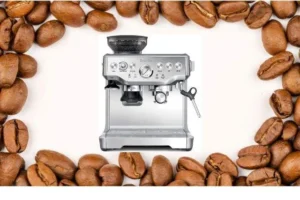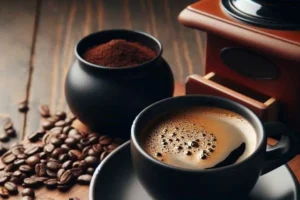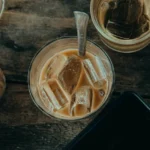Cold Brew Coffee: The Complete Guide
Cold brew coffee has become a rising star in cafes and coffee shops around the world. Often served chilled over ice, this smooth, low-acid coffee beverage offers a refreshing twist on traditional hot coffee. But what exactly is cold brew, and how did it become so popular?
How to Make Cold Brew Coffee: Key Takeaways
- Cold Brew Basics: Cold brew is made by steeping coarse coffee grounds in cold water for 12 hours or more, resulting in a smooth, naturally sweet concentrate best served chilled or over ice.
- Historical Roots: Cold brew has been enjoyed for centuries, with a recent surge in popularity due to artisanal offerings in cafes and coffee shops.
- Advantages: Cold brew offers a smooth, less acidic taste with higher caffeine levels compared to hot coffee.
- Minimal Equipment: Making a cold brew at home is simple, requiring coffee beans, filtered water, a grinder, a filtration system, and a storage container.
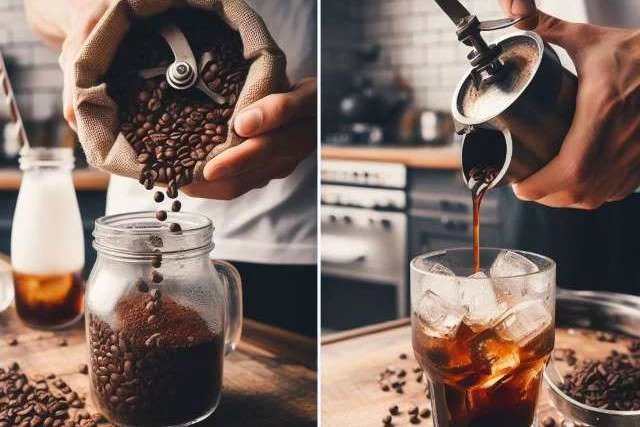
What is Cold Brew Coffee?
Cold brew coffee is made by steeping coarse-ground coffee beans in room temperature or cold water for an extended period, usually 12 hours or longer. This slow steeping process allows the water to extract the coffee’s flavorful oils and aromas without extracting bitter compounds, which are more soluble in hot water. The end result is a smooth, naturally sweet coffee concentrate that can be enjoyed chilled or diluted with water or milk over ice.
Unlike conventional iced coffee, which is simply hot-brewed coffee poured over ice, cold brew’s signature flavor stays smooth and mellow when served cold. The lower temperature brewing also yields higher caffeine levels than drip or pour-over hot coffee methods. These characteristics have fueled cold brew’s rapid rise from indie cafe novelty to mainstream staple.
History of Cold Brew Coffee
While cold brew coffee has recently surged in popularity, its simplicity has made it a coffee-brewing go-to for centuries.
- In 1600s Japan, a cold-steeped coffee drink called Kyoto-style coffee was made by slowly dripping room temperature water through coffee grounds for over 12 hours.
- In tropical regions in the 1800s, like Brazil and Cuba, cold brew was often preferable to hot coffee to help beat the heat.
- The modern cold brew craze began over the last 10-15 years, with independent cafes and coffee shops offering taps of their unique cold brew concoctions. Trendy third-wave coffee shops popularized artisanal cold brews made with high-quality beans and filtered water.
- Cold brew’s photogenic glass bottles and smooth flavor profile made it a social media darling. Major chains like Starbucks began offering cold brew nationwide in 2016.
Today it’s rare to find a coffee shop without cold brew on the menu, now considered a standard for cafes and coffee lovers worldwide.
Advantages of Cold Brew

What sets cold brew apart from other coffee drinks? Here are some of the defining characteristics that make cold brew irresistible:
Smooth Flavor
The low-temperature steeping process results in a naturally mellow flavor that lacks the bitterness and acidity associated with hot coffee. Cold brew is often described as having subtle chocolate or caramel notes. Many find it pleasant to drink black and avoid adding cream or sweetener that might hide its delicate flavor.
Lower Acidity
The cold water used for brewing lessens acid extraction from the coffee beans versus hot water methods. This reduces the tart, tangy taste that can make hot black coffee hard on sensitive stomachs. The lower acidity makes cold brew easier to drink for those prone to heartburn or acid reflux.
Higher Caffeine Content
While cold brew tastes incredibly smooth, it can contain significantly higher levels of caffeine compared to drip coffee. The long immersion time allows for full caffeine extraction from the coffee grounds. Studies have found cold brew to have about 25% to 30% more caffeine than hot drip coffee.
Versatility in Serving
Cold brew’s mild flavor profile makes it adaptable for both purist coffee drinkers and those who enjoy coffeehouse-style cream and sugar drinks. It shines served black over ice but also takes well to milk, sweeteners, and flavors like vanilla, caramel, or chocolate that add sweetness and creaminess. The concentrate dilutes smoothly for customized coffee strength.
Equipment Needed
Part of the widespread appeal of cold brew is that it requires very little specialized equipment. Here are the minimal tools needed:
| Equipment | Description |
| Coffee Beans | High-quality Arabica beans preferred, whole beans, freshly ground. |
| Water | Good filtered water recommended for the best flavor. |
| Grinder | Consistent coarse grind; Burr grinders provide even grinding. |
| Filtration System | To separate finished coffee from grounds. Options: French press, filters, nut milk bags, or specialty cold brew systems. |
| Storage Container | Glass jugs or mason jars for easy viewing; opaque containers also work. |
The Cold Brewing Process
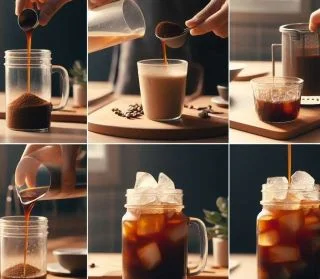
While cold brew involves a simple concept, tweaking different variables in the steeping process can fine-tune the coffee’s flavor and strength.
Brew Time
The defining aspect of cold brew is the extended extraction time, usually between 12 to 24 hours. This prolonged brewing gently coaxes nuanced flavors from the coffee grounds. Time can be adjusted based on individual preference. 12 hours makes a mellow brew while 18+ hours yields a more robust flavor.
Water-to-Coffee Ratio
The proportion of water to coffee grounds affects the dilution and strength of the final cold brew concentrate. A typical ratio is 3-4 parts water to 1 part coarsely ground coffee. The amount of water can be adjusted to find your ideal ratio, from strong 2:1 to milder 4:1 concentrations.
Steeping Temperature
Strictly speaking, authentic cold brew uses cool, room-temperature water between 60°F to 72°F. Some recipes call for starting with hot water that is fully cooled before pouring over the coffee grounds. This is optional, as room temperature water still extracts full flavor over a long steep time.
Brew Methods
Immersion: The simplest cold brew method where coffee grounds are fully submerged and soaked in a container of water. This allows for easy batch steeping. The grounds are filtered out at the end of the process.Drip: Water is slowly dripped through a filter containing the coffee grounds, like Japanese-style cold brew. Takes more time but involves less filtration needed at the end.
Choosing the Right Coffee Beans
When selecting beans for an immaculate cold brew, keep these factors in mind:
- Bean Type: Go for all Arabica or a blend of Arabica and Robusta. Arabica offers complexity while Robusta adds body.
- Roast Level: Medium to dark roasts are recommended, as very light roasts can taste sour when cold brewed.
- Grind Size: Use a coarse grind, around the texture of kosher salt. Too fine over extracts and makes gritty cold brew.
- Flavor Notes: Beans with chocolate, caramel, or nutty notes pair perfectly with cold brew. Fruitier beans get muted.
Water Quality
Because cold brew contains just two main ingredients, coffee and water, the taste and minerals in the water significantly impact the end flavor.
- High-quality filtered water provides the cleanest-tasting cold brew, free of tastes and impurities. Pitcher filters like Brita are an easy option. More advanced reverse osmosis systems can remove more minerals.
- Cold brew’s delicate flavor profile really allows subtleties from the water to shine through. Using pure, good-tasting water allows the coffee’s nuances to take center stage.
- For proper extraction during steeping, room temperature or cool water between 60°F and 72°F should always be used when making cold brew. Hot water is not necessary and can scald the grounds creating bitter, over-extracted results.
| Water Type | Benefits | Potential Drawbacks |
| Tap water | Convenient, inexpensive | Can contain high mineral content, chlorine, fluoride, other impurities that affect taste |
| Pitcher filter (Brita) | Affordable, convenient. Removes chlorine and some minerals. | May not remove all dissolved solids. Requires filter replacements. |
| Reverse osmosis system | Removes up to 99% of contaminants and minerals. | More expensive systems. Can strip away beneficial minerals. |
Cold Brew Recipes
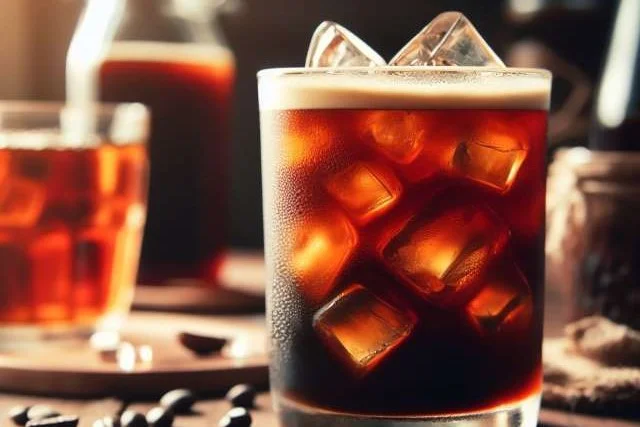
One of the joys of cold brew is how adaptable it is to customization with different beans, flavors, extras and serving methods:
- Classic Black Cold Brew: Use a 3:1 water-to-coffee ratio. Steep for 12-24 hours, filter, then dilute concentrate to taste and enjoy straight over ice.
- Flavored Cold Brews: Add vanilla, cinnamon, citrus peels, spices, or other mix-in flavors to the brewing container. Steep 1-2 days to infuse. Fine-strain concentrate before serving for bolder infused flavor.
- Cold Brew Concentrate: Use an extra-strong 2:1 water-to-coffee ratio and steep 18+ hours. Dilute concentrate 1:1 with water, milk, or ice for customizable coffee strength. Lasts up to 2 weeks refrigerated.
- Creamy Cold Brew Lattes: Mix cold brew with milk, cream, or non-dairy alternatives. Sweeten if desired. Top with foamed milk or espresso shots for an indulgent treat.
Serving and Presentation
Cold brew is infinitely Instagrammable. Make your cold brew shine with these irresistible serving styles:
- Glassware: Show off the beautiful dark coffee concentrate in glass carafes, beakers, or mason jars. Serve over ice in elegant stemmed glasses, trendy copper mugs, or portable tumblers.
- Ice: The proper ratio for serving is 2 parts cold brew to 1 part ice cubes. Too much ice dilutes the flavor. Crushed ice can be used for texture.
Fancy Extras: Get creative with gourmet garnishes like whipped cream, chocolate shavings, cinnamon, fruits, edible flowers. Sprigs of mint or lavender make cold brew look stunning.
Cold Brew Culture
Cold brew’s meteoric rise from indie cafes to mainstream staples reflects growing coffee culture trends:
- Surging Popularity: According to market research, United States cold brew sales escalated 580% between 2011 to 2016.
- Dedicated Brands: Devoted cold brew brands like Grady’s, Kohana, High Brew, and more fuel the craze. Bottled cold brew makes grabbing a cold brew on the go easy.
Innovative Variations: New preparation methods like nitro cold brew, cold foam, and trendy recipes keep cold brew exciting. Cold brew floats, popsicles, and cocktails show its versatility.
Health Benefits
With approximately 30% more caffeine than hot drip coffee, cold brew provides an energizing lift. But it offers other healthy advantages as well:
- Antioxidants – Cold brew retains many of coffee’s natural plant-based antioxidants and polyphenols linked to better heart health, brain function, cancer prevention, and diabetes risk reduction.
- Reduced Acidity – The lower acidity of cold brew versus hot is easier on sensitive stomachs and beneficial for reducing heartburn or reflux.
- Low Calorie – Straight black cold brew is naturally sugar-free, with just 2 calories per 8 oz cup. It provides energy via caffeine without empty calories leading to weight gain.
- Hydration – Cold brew’s refreshing chilled serving temperature and smooth flavor make it an appealing hydrating drink. It’s a healthy lower-calorie swap for water or sugar-filled sports drinks when working out.
Cold Brew vs. Iced Coffee
While cold brew and traditional iced coffee may seem similar, there are some important distinctions between the two popular chilled coffee drinks:
- Brewing: Iced coffee is made by double brewing standard drip coffee hot before pouring it over ice to chill. Cold brew steeps grounds in room temp water 12+ hours.
- Flavor: Iced coffee often retains more of coffee’s natural acidity. Cold brew has a rounder, smoother taste profile.
- Caffeine: The cold water extraction boosts cold brew’s caffeine content to about 30% higher than hot-brewed iced coffee.
Cold Brew at Home vs. Buying Premade
Both making cold brew yourself and grabbing a bottle have their perks:
- Cost: Doing it yourself costs around $0.20 to $0.30 per 12-16 oz cup using your own beans and filters. Pre-made bottles cost $3 to $5.
- Convenience: Store-bought saves time and effort while homemade allows you to tweak recipes to your taste with preferred beans and strengths.
- Support Local: Purchasing cold brew from cafes helps small businesses. But homemade gives you full control over the brewing.
Storing Cold Brew
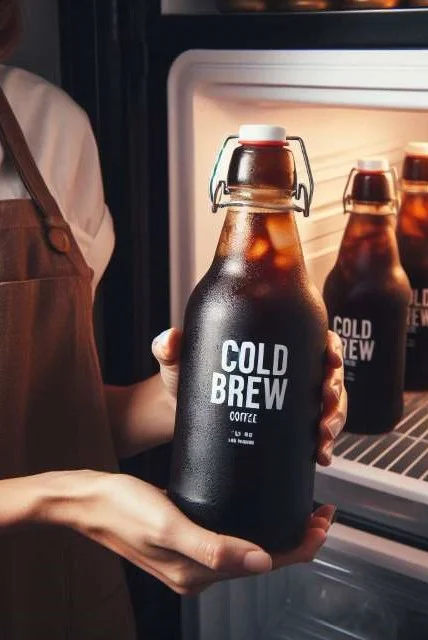
To enjoy fresh cold brew anytime, adhere to these storage tips:
- Fridge Storage: Fresh cold brew concentrate should be stored in an airtight container in the refrigerator. Properly stored, it keeps for 1-2 weeks refrigerated.
- Diluted Shelf Life: The shelf life of ready-to-drink diluted cold brew is shorter at 3-5 days maximum when refrigerated in an airtight container.
- Avoid Dilution: Use coffee ice cubes to prevent flavor dilution from regular cubes melting. Also avoid storing in containers prone to cracking that leads to leakage.
Cold Brew Cocktails
Cold brew’s versatility extends to spirited coffee cocktails as well:
- Cold Brew Martini: Combine cold brew, vodka or gin, coffee liqueur, and simple syrup for an alcoholic pick-me-up. Garnish with coffee beans.
- Cold Brew Kahlúa: Mix cold brew, vodka, and Kahlúa over ice for a spin on the classic Black Russian cocktail.
- Espresso Martini Twist: Swap espresso for cold brew, vodka, coffee liqueur, and vanilla syrup for a chilled Espresso Martini with a hint of natural sweetness.
Sustainability and Cold Brew
From fair bean sourcing to eco-packaging, responsible cold brew brands implement sustainability:
- Ethical Sourcing: Direct trade relationships ensure fair farmer wages. Choosing organic and shade-grown beans protects local environments.
- Eco-Friendly Packaging: Many bottled cold brew makers use recyclable bottles, biodegradable pods, and zero-waste systems like reusable bottles.
Waste Reduction: Small-batch homemade production minimizes waste. Reusable steel filters and compostable coffee grounds reduce environmental impact.
The Cold Brew Trend in Cafés
From new preparation techniques to one-of-a-kind flavors, cafes are pushing cold brew creativity:
- Innovative Offerings: Menus now include single origin cold brew, cold brew on tap, nitro cold brew, limited seasonal flavors, and trendy creamy cold foam cold brew.
- Unique Flavors: Baristas mix cold brew with ingredients like tea, hibiscus, maple syrup, lavender, cardamom, and more for creative flavor fusions.
- Branding: Hashtags like #coldbrew draw social media engagement. Photogenic taps and beakers give cold brew drinks an artisanal vibe that attracts crowds.
Cold Brew Coffee Around the World
- Regional Favorites: Syrupy sweetened condensed milk added to cold brew is a hit across parts of Asia. Mexican café de olla features cinnamon cold brew.
- International Trends: Beloved from Japan to Australia to Europe and beyond, cultural influences lead to local innovations like Vietnamese egg coffee cold brew.
- Global Flavors: From floral rose water in the Middle East to toasted rice cold brew in Thailand, diverse spices and ingredients create unique flavor fusions.
Interview with a Cold Brew Expert
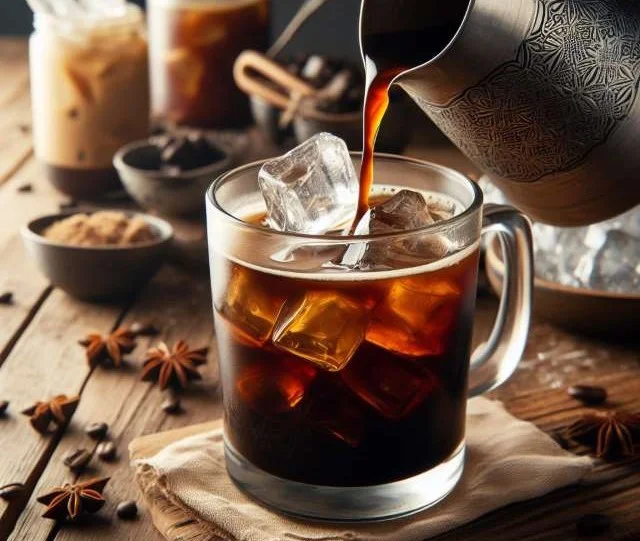
To get professional advice on crafting exquisite cold brew, I interviewed Alex, an experienced barista at a specialty coffee shop praised for its cold brew program:
Q: What tips do you have for beginners making cold brew at home?
A: Focus on a consistent coarse grind, around the size of kosher salt grains. And use filtered water if possible – it makes a big difference in taste. Don’t steep longer than 24 hours maximum.
Q: What are your thoughts on the popularity of cold brew taps at coffee shops?
A: They allow us to offer a wide variety of rotating single-origin and seasonal cold brew options. Customers enjoy getting to see us freshly pour cold brew straight from the tap right in front of them!
Troubleshooting Common Issues
Like any brewing method, cold brew can have some technical difficulties. Here are tips to overcome common problems:
- Bitter flavor: Coarsen the grind, steep for less time, or rinse the grounds first. Overextraction causes bitterness.
- Weak brew: Use more grounds, steep longer, or dilute less when serving. Weak flavor comes from underextracted beans.
- Cloudy appearance: Fine grit suspended in the brew causes cloudiness. Paper filter or let the brew settle before pouring.
Conclusion
With its smooth taste, energizing caffeine content, and endless customizability, cold brew has become a fixture in the coffee world and beyond. Its rise reflects shifting consumer preferences valuing convenience, creative flavors, and photogenic drinks suits for social media sharing. Cafes continue innovating new styles while large chains make cold brew increasingly accessible. Driven by its refreshing flavor profile and better-for-you hydrating qualities versus sugary soft drinks, the cold brew phenomenon is only slated to continue expanding. No longer just a hipster niche, cold brew coffee has been fully embraced by the masses as an essential iced coffee drink to be enjoyed year round.
How to Make Cold Brew Coffee
Properly stored cold brew concentrate will maintain peak quality and taste for 1-2 weeks when you keep it refrigerated in an airtight container. The shelf life for ready-to-drink diluted cold brew is shorter at just 3-5 days when refrigerated since the water hastens spoilage.
Medium to dark roasted Arabica coffee beans, or a blend that incorporates some Robusta along with the Arabica, turn out great cold brew. Go for beans that have tasting notes of chocolate, caramel, nuttiness or sweetness so those flavors come through clearly. You’ll want to avoid very light roasts as they can end up sour when cold brewed.
You can readily whip up cold brew at home without any special gadgets or devices. All you really require is coffee grounds, water, a container to steep the grounds in, and some kind of filter. A French press or even just a nut milk bag suspended inside a jar can get the job done. The keys are using a coarse grind and giving the grounds a long immersion time.
Yes, cold brew offers some health advantages over hot-brewed iced coffee. The cold water extraction preserves 30% more antioxidants from the beans versus hot coffee. Additionally, cold brew is less acidic, making it gentler on sensitive stomachs and helpful for avoiding heartburn or reflux problems that some people experience with hot coffee.
Some naturally sweeter medium roast coffee beans can eliminate the need for adding sugary sweeteners. Cream or milk lend a touch of sweetness along with richness. Vanilla extract is another way to impart a hint of sweetness. Finally, using frozen fruit like berries in your ice cubes releases subtle natural sweetness as the cubes dilute into the cold brew.

